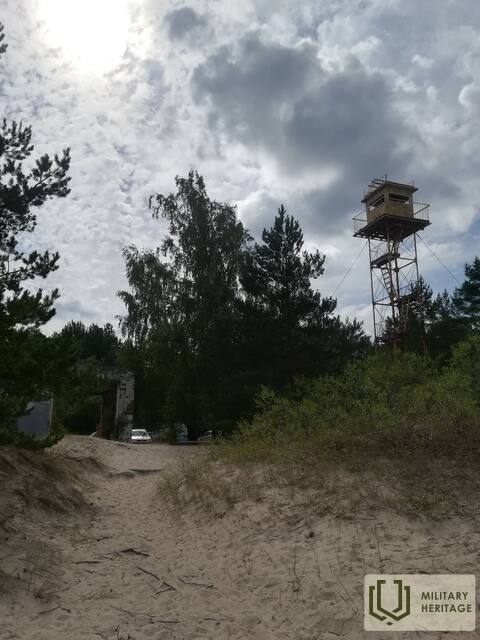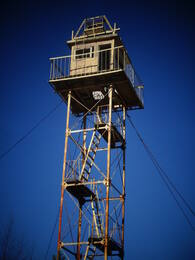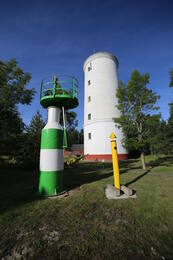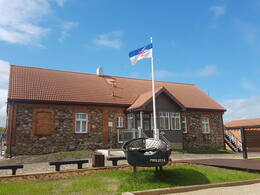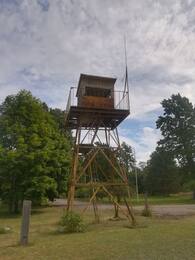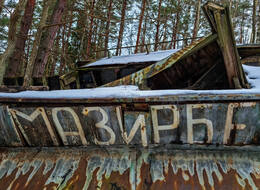Border regime zone
About times in the border regime zone.
When I first started working at the Slītere State Reserve, I didn’t really know the border procedures yet. One evening, I took the last bus to Mazirbe, where we were stopped by border guards. One of them looked at my passport and pointed out that I lived in Slītere, not Mazirbe. But I asked him “A pečatj tam estj” (But, is there a stamp there (in the passport)?). He waved me away, but he still let me into Mazirbe.
In turn, my husband (who worked in the Ezeri forestry department at the time) told a story about how one summer day he decided to walk along the beach from Melnsilas to Kolka. He did so until he heard behind him "Stoj, ruki verh!" (Stand up, hands in the air!). So he walked several kilometers with his hands in the air to Uši, where his identity was established at a pole socket (at that time there were portable telephones and certain connection points from which one could communicate). After that, he was fired.
At that time, there was a mobile missile base in Ushi. The trenches and pits there still survive to this day. The coastal road was also built as a strategic object. Along its edge, markers were dug in every section (some say they still exist) so that precise coordinates could be determined.
Related timeline
Related objects
Mazirbe border guard tower
The Soviet border defence post was located in the building that used to be a maritime school, and next to it is a well-preserved Soviet border guard watchtower. The second watchtower is located right on the shore next to a parking lot. These watchtowers are a reminder of the Soviet occupation and the times when Mazirbe was a closed border area and civilians were allowed on the shore only in specially designated places and only during the daytime. This border guard watchtower is one of the best-preserved objects of its type on the coast of Latvia. However, it designated is dangerous to climb it.
Oviši Lighthouse and Soviet border guard
Oviši Lighthouse is located in the Tārgale parish in a village called Oviši on the coast of Kurzeme. It was built in 1814 and it is the oldest lighthouse in Latvia. The height of Oviši Lighthouse tower is 37 m. The lighthouse has a double-cylinder design: its diameter is 11.5 m, but within the stone wall there is a second tower with a diameter of 3.5 m. Such double-cylinder lighthouses were used also as defensive structures in the 18th-19th century Europe in case of enemy attacks. The Oviši Lighthouse Museum is considered to have the largest collection of lighthouse equipment and maritime navigation items among all Latvian lighthouse museums. When the weather is right the Irbe Lighthouse can be seen from Oviši Lighthouse.
At the end of World War II, the headquarters of the Beminger Battalion of the German Army was located near the Oviši Lighthouse along with the 4th Battery of the 530th Naval Artillery Division with several anti-aircraft guns. It is said that there was a radio direction finder and an infrared ray detection station Donau Gerät located at the foot of the lighthouse. A Soviet border guard post was once located near the lighthouse, but none of the Soviet-era buildings have survived. The Oviši station building is still located in the territory of the lighthouse.
Pāvilosta local history museum exposition
Named ‘Pāvilosta, a Closed Area’, the exhibit in the Pāvilosta Local History Museum is about everyday life in the town of Pāvilosta during the Soviet occupation; specifically, about the executive branch, border area, fishermen’s collective farm, and the cultural and social activities. In addition to the permanent exhibit, there is an interactive and emotionally rich digital exhibit in two languages and an audio-visual installation offering a film about Pāvilosta.
The museum also features a new exhibit named ‘The Golden Sand Grains of Pāvilosta’. The digital installation showcases old events, how Pāvilosta was founded and the most important developments from 1918 to the present day. Military heritage is a point of focus in the War of Independence section, which tells a story about the freedom fighters of Latvia and the time of the Soviet occupation.
Mazirbe Nautical School
The Soviet Border Guard Tower in this complex is one of the best preserved of its kind on the Latvian coast. Unfortunately, the condition of the buildings is poor, there is a rifle loading/unloading site on the site, and a drive and fragments of trenches have been salvaged.
The Coast Guard post was located in the former Marine School building. In the post-Soviet period, accommodation was offered in parts of the buildings.
The second tower of the Soviet Border Guard is located about 400 m from the beach, but unfortunately it is in a state of disrepair. However, the Mazirbe boat cemetery is located not more than 500 m from the beach tower towards Sīkrags.
Mazirbe boat cemetery
Mazirbe, historically known as the largest Liv centre, is notable for the only fishermen's boat cemetery on the Latvian coast. It was built in the 1960s, the last boats were brought in 1976. The boats ended up here as a result of both fishing restrictions and age.
Today, Mazirbe has less than ten wrecks of fishing boats, but historically there have been many more. Boats have been laid to rest in other seaside villages, but it is in Mazirbe's boat graveyard that this is most evident today.
The Mazirbe Boat Cemetery is the only one of its kind on the Latvian coast.




